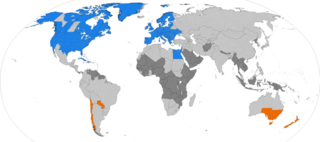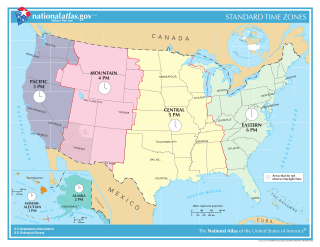Related Research Articles

Daylight saving time (DST), also referred to as daylight savings time, daylight time, or summer time, is the practice of advancing clocks to make better use of the longer daylight available during summer, so that darkness falls at a later clock time. The typical implementation of DST is to set clocks forward by one hour in spring or late winter, and to set clocks back by one hour to standard time in the autumn.

The Alaska Time Zone observes standard time by subtracting nine hours from Coordinated Universal Time (UTC−09:00). During daylight saving time its time offset is eight hours (UTC−08:00). The clock time in this zone is based on mean solar time at the 135th meridian west of the Greenwich Observatory.

In the United States, time is divided into nine standard time zones covering the states, territories and other US possessions, with most of the country observing daylight saving time (DST) for approximately the spring, summer, and fall months. The time zone boundaries and DST observance are regulated by the Department of Transportation, but no single map of those existed until the agency announced intentions to make one in September 2022. Official and highly precise timekeeping services (clocks) are provided by two federal agencies: the National Institute of Standards and Technology (NIST) ; and the United States Naval Observatory (USNO). The clocks run by these services are kept synchronized with each other as well as with those of other international timekeeping organizations.

Summer time in Europe is the variation of standard clock time that is applied in most European countries in the period between spring and autumn, during which clocks are advanced by one hour from the time observed in the rest of the year, with a view to making the most efficient use of seasonal daylight. It corresponds to the notion and practice of daylight saving time (DST) to be found in some other parts of the world.
Time in New Zealand is divided by law into two standard time zones. The main islands use New Zealand Standard Time (NZST), 12 hours in advance of Coordinated Universal Time (UTC) / military M (Mike), while the outlying Chatham Islands use Chatham Standard Time (CHAST), 12 hours 45 minutes in advance of UTC / military M^ (Mike-Three).

The Atlantic Time Zone is a geographical region that keeps standard time—called Atlantic Standard Time (AST)—by subtracting four hours from Coordinated Universal Time (UTC), resulting in UTC−04:00. AST is observed in parts of North America and some Caribbean islands. During part of the year, some portions of the zone observe daylight saving time, referred to as Atlantic Daylight Time (ADT), by moving their clocks forward one hour to UTC−03:00. The clock time in this zone is based on the mean solar time of the 60th meridian west of the Greenwich Observatory.

UTC−03:00 is an identifier for a time offset from UTC of 06

UTC+03:00 is an identifier for a time offset from UTC of +03:00. In areas using this time offset, the time is three hours later than the Coordinated Universal Time (UTC). Following the ISO 8601 standard, a time with this offset would be written as, for example, 2019-02-08T23:36:06+03:00.

There are eleven time zones in Russia, which currently observe times ranging from UTC+02:00 to UTC+12:00. Daylight saving time (DST) has not been used in Russia since 26 October 2014. From 27 March 2011 to 26 October 2014, permanent DST was used.
Philippine Standard Time, also known as Philippine Time (PHT), is the official name for the time zone used in the Philippines. The country only uses a single time zone, at an offset of UTC+08:00, but has used daylight saving time for brief periods in the 20th century until July 28, 1990.

East Africa Time, or EAT, is a time zone used in eastern Africa. The time zone is three hours ahead of UTC (UTC+03:00), which is the same as Moscow Time, Arabia Standard Time, Further-eastern European Time and Eastern European Summer Time.
Samoa uses UTC+13:00 as standard time. It observed daylight saving time from 2010 to 2021, which it observed during summer in the Southern Hemisphere. In 2011, daylight saving time ended on Saturday, 2 April 2011, 04:00 local daylight time and started on Saturday, 24 September 2011, 03:00 local standard time. Because it is located near the equator, Samoa traditionally did not observe daylight saving time. The introduction of daylight saving time was initially planned for 2009 but was postponed for one year in the aftermath of the 2009 Samoa tsunami.

As of 2022, daylight saving time is used in the following Asian countries:

African countries, apart from Egypt, do not use daylight saving time (DST) although some did in the past. Only the territories of the Canary Islands, Ceuta and Melilla (Spain) and Madeira (Portugal) implement DST from the last Sunday in March to the last Sunday in October. Although these regions politically belong to Europe, they are geographically part of Africa. They have DST schedules according to European Union rules.

Daylight saving time (DST), also known as summer time, is the practice of advancing clocks during part of the year, typically by one hour around spring and summer, so that daylight ends at a later time of the day. As of 2024, DST is observed in most of Europe, most of North America and parts of Africa and Asia around the Northern Hemisphere summer, and in parts of South America and Oceania around the Southern Hemisphere summer. It was also formerly observed in other areas.

Spain has two time zones and observes daylight saving time. Spain mainly uses CET (UTC+01:00) and CEST (UTC+02:00) in Peninsular Spain, Ceuta, Melilla and the plazas de soberanía. In the Canary Islands, the time zone is WET (UTC±00:00) and WEST (UTC+01:00). DST is observed from the last Sunday in March to the last Sunday in October throughout Spain.
Time in the Kingdom of the Netherlands is denoted by Central European Time during the winter as standard time in the Netherlands, which is one hour ahead of coordinated universal time (UTC+01:00), and Central European Summer Time (CEST) during the summer as daylight saving time, which is two hours ahead of coordinated universal time (UTC+02:00). The Caribbean Netherlands – which consist of the islands of Bonaire, Sint Eustatius and Saba – all observe Atlantic Standard Time (AST) year-round, which is four hours behind coordinated universal time (UTC−04:00).
In Croatia, the standard time is Central European Time. Daylight saving time is observed from the last Sunday in March to the last Sunday in October.
In Serbia, the standard time is Central European Time. Daylight saving time is observed from the last Sunday in March to the last Sunday in October. Serbia adopted CET in 1884.

Time in Poland is given by Central European Time. Daylight saving time, which moves an hour ahead, is observed from the last Sunday in March to the last Sunday in October. This is shared with several other EU member states.
References
- ↑ "Ethiopia Time Zone - Ethiopia Current Time". www.timetemperature.com.
- ↑ ISO 3166-2:ET#Current codes
- ↑ "Daylight Saving Time Changes 2020 in Addis Ababa, Ethiopia". www.timeanddate.com.
- ↑ "Travel Tips".
- ↑ "Green Land Tours and Travel, services with utmost satisfaction in Ethiopia". www.greenlandethiopia.com. Archived from the original on 2007-11-14.
- ↑ "If you have a meeting in Ethiopia, you'd better double-check the time". The World (radio program) . 2015-01-30. Archived from the original on 2015-02-01.